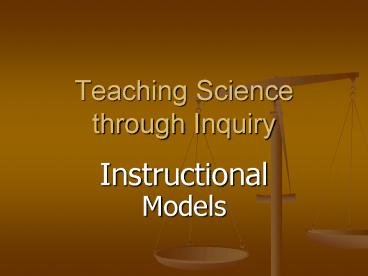Teaching Science through Inquiry - PowerPoint PPT Presentation
1 / 10
Title:
Teaching Science through Inquiry
Description:
Guided Discovery. Set up introductory questions to initiate exploration ... Feel science is more useful in their every-day lives. Have greater feelings of success ... – PowerPoint PPT presentation
Number of Views:1930
Avg rating:3.0/5.0
Title: Teaching Science through Inquiry
1
Teaching Science through Inquiry
- Instructional Models
2
Instructional Model
An Instructional Model is an organized approach
to teaching. It involves some arrangement of
phases, steps, actions, or decisions.
There is not one model that is best for all
teachers, all students, all the time.
3
4 Instructional Models that could be used for
Inquiry Instruction
- Guided Discovery Model
- Learning Cycle
- Conceptual Change Model
- 5-E Model
These instructional modes differ in procedures,
but they all focus on helping learners build
understanding of the natural world. When teaching
certain kinds of lessons one model may work
better than another.
4
Guided Discovery
- Set up introductory questions to initiate
exploration - Provide discovery materials
- Assist them in keeping the discovery question in
mind - Occasionally focus or redirect students
activities - Give them selected information
- Discussion time for students to share their
procedures and discoveries
5
Learning Cycle
- Exploration, in which students discover new
knowledge - Concept Invention, in which students acquire
knowledge from teacher - Concept Application, in which students construct
new understandings from their discovered and
acquired knowledge
6
Conceptual Change Model
- In early childhood, a state of equilibrium
exists--the reality of the outside world
matches the childs cognitive beliefs. - As children get older they begin to see a
discrepancy between their present beliefs and the
contradictory beliefs of others which causes
disequilibrium. - At this point, the child must make accommodations
within their cognitive structure to allow new
knowledge to replace the previous.
7
Conceptual Change Model, Cont.
- The child has made changes in the way he/she
perceives and understands a particular concept or
phenomenon. This is called the conceptual change
model. - Challenging children and causing them to modify
misconceptions takes much patience and
persistence. - First, you must uncover the students
misconception. - Peers can be a strong motivator for giving up
misconceptions and undergoing cognitive
conceptual change.
8
Conceptual Change Model, Cont.
- A word of caution, peers also have their own
naïve conceptions. - Students will change their conceptions when a)
they become dissatisfied with their existing
conditions b) the new concept is intelligible,
appears plausible and is useful.
9
5-E Model
- Engage
- Explore
- Explain
- Elaborate
- Evaluate
You may also encounter a sixth Ee-search.
E-search encompasses any use of electronic media
that ties the 5 stages together.
10
Research has shown that when compared to
traditional, book-oriented science programs,
students that engage in discovery and inquiry
science class
- Find science more exciting and interesting
- Wish they had more science
- Feel science is more useful in their every-day
lives - Have greater feelings of success
- Have a more positive view of science and scientist































